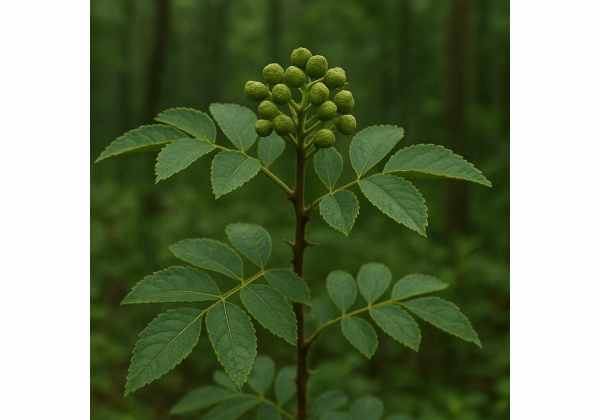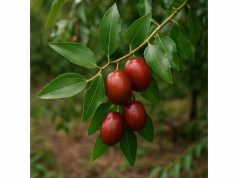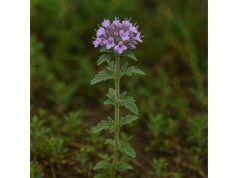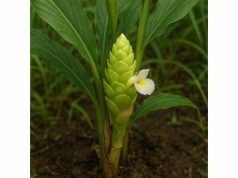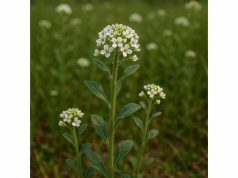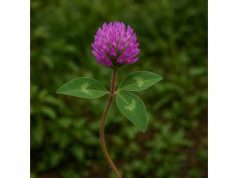Zanthoxylum, commonly known as Sichuan pepper or prickly ash, is prized for its unique, tingling flavor and impressive health-promoting profile. This botanical marvel boasts active compounds such as hydroxy-α-sanshool, limonene, and flavonoids that deliver analgesic, anti-inflammatory, and antioxidant benefits. Traditionally used in Chinese, Ayurvedic, and Native American medicine, Zanthoxylum relieves digestive discomfort, soothes joint pain, and supports cardiovascular health. Its versatile applications range from culinary spice to herbal teas, essential oils, and topical poultices. With a growing body of research validating its therapeutic properties, Zanthoxylum continues to gain recognition as a powerful natural remedy and flavor enhancer.
Table of Contents
- Botanical Portrait and Growth Conditions
- Phytochemical Profile and Key Elements
- Therapeutic Benefits and Intrinsic Qualities
- Practical Applications and Safety Measures
- Evidence-Based Studies and Research Highlights
- FAQ
Botanical Portrait and Growth Conditions
Zanthoxylum belongs to the Rutaceae family, encompassing about 250 species of shrubs and small trees. The most commonly used varieties—Zanthoxylum piperitum (Japanese prickly ash) and Zanthoxylum simulans (Chinese prickly ash)—display distinctive morphological features. Mature plants reach heights of 2–5 meters, bearing pinnate leaves with 5–11 obovate leaflets that range from glossy green above to pale beneath. Clusters of small, inconspicuous greenish-yellow flowers bloom in spring, giving way to round, reddish-brown fruit capsules that split open when ripe to reveal shiny black seeds surrounded by a papery husk.
Native to East Asia and parts of North America, Zanthoxylum thrives in well-drained, loamy soil with moderate moisture. In its native Himalayan foothills, the plant prefers altitudes between 500 and 2,000 meters, where cool nights and warm days foster optimal essential oil development. Cultivation has since extended to gardens and orchards worldwide, with growers recommending partial shade to protect young plants from scorching midday sun, while mature specimens benefit from full sun exposure. Propagation typically occurs via seeds—soaked for 24 hours before sowing—or through semi-hardwood cuttings taken in late summer.
Seasonal care includes pruning in late winter to maintain shape and encourage vigorous new shoots. Fertilize annually with balanced, slow-release formulations to support flowering and fruit set. Mulching helps conserve soil moisture and suppress weeds, while periodic irrigation during dry spells ensures healthy growth. Harvesting takes place in early autumn, once the fruit capsules have fully opened on the branch. Collect the husks and seeds, then dry them in a shaded, airy space to preserve the volatile sanshool compounds responsible for the signature numbing sensation. Proper drying and storage in airtight containers shield the husks from moisture and light, retaining peak flavor and medicinal efficacy for up to one year.
Ecologically, Zanthoxylum provides habitat and nourishment for pollinators and birds, while its thorny branches deter grazing by herbivores. Gardeners value it as both an ornamental specimen, with its textured bark and vivid autumnal hues, and a functional spice plant. Understanding the plant’s botanical requirements and growth cycle is crucial for cultivating high-quality Zanthoxylum that yields potent active compounds.
Phytochemical Profile and Key Elements
Zanthoxylum’s therapeutic virtues emanate from a rich blend of unique phytochemicals. The following examination outlines the most impactful constituents:
- Hydroxy-α-sanshool
- The molecule behind Sichuan pepper’s signature tingling and numbing effect. Hydroxy-α-sanshool interacts with TRPV1 and TRPA1 receptors in sensory neurons, providing mild analgesia and stimulating salivation and digestion.
- Limonene
- A monoterpene terpene known for its citrus aroma and mood-lifting properties. Limonene exhibits anti-inflammatory and gastroprotective actions, aiding in the prevention of ulcers and soothing gastrointestinal lining.
- γ-Terpinene
- Another monoterpene abundant in Zanthoxylum essential oil. It contributes antioxidant and spasmolytic benefits, relaxing smooth muscles in the digestive and respiratory tracts.
- Kaempferol and Quercetin
- Flavonoid antioxidants that scavenge free radicals and support cardiovascular wellness. Kaempferol modulates vasodilation, while quercetin stabilizes mast cells, reducing allergic responses.
- Borneol
- A bicyclic monoterpenoid with mild analgesic and anti-inflammatory effects. Borneol enhances transdermal absorption of other compounds, making it a valuable penetration enhancer in topical formulations.
- Palmitic and Oleic Acids
- Fatty acids present in the husk that lend skin-nourishing and anti-inflammatory properties when applied as infused oils or balms.
- Alkaloids (e.g., Chelerythrine)
- Bioactive alkaloids that offer antimicrobial and anti-cancer potential. Chelerythrine, in particular, has shown to inhibit certain tumor cell lines in preliminary in vitro studies.
- Linalool
- A monoterpene alcohol with calming, anxiolytic properties. Linalool contributes to the essential oil’s relaxing scent and supports stress reduction when used in aromatherapy.
- Sesamin
- Lignan-type phytoestrogen with antioxidant and neuroprotective actions. Although present in smaller amounts, sesamin complements the flavonoids in bolstering cellular resilience against oxidative stress.
- Mucilaginous Polysaccharides
- These viscous fibers soothe mucous membranes in the gastrointestinal tract, easing heartburn and acid reflux.
Together, these compounds generate synergistic effects: the sanshools and terpenes relieve pain and spasm; flavonoids and lignans neutralize oxidative damage; and alkaloids alongside fatty acids deliver antimicrobial and skin-supportive actions. The precise ratios vary by species, terroir, and harvest time, reinforcing the importance of thoughtful cultivation and processing to maximize active compound profiles.
Therapeutic Benefits and Intrinsic Qualities
Zanthoxylum’s eclectic phytochemistry translates into a wide-ranging health portfolio:
- Analgesic Relief:
Hydroxy-α-sanshool’s modulation of sensory receptors provides a natural, mild numbing effect. Topical applications can help ease muscle aches, joint discomfort, and neuralgia without the side effects associated with synthetic analgesics. - Anti-Inflammatory Action:
Monoterpenes like limonene and γ-terpinene inhibit pro-inflammatory enzymes (COX-2, LOX), reducing swelling and redness in arthritic joints and inflamed tissues. Regular dietary use or topical application can complement conventional anti-inflammatory therapies. - Digestive Support:
By stimulating salivary and gastric secretions, Zanthoxylum enhances nutrient breakdown and absorption. Its spasmolytic terpenes relax gastrointestinal smooth muscles, alleviating cramping, bloating, and indigestion. - Antioxidant Defense:
Flavonoids (kaempferol, quercetin) and lignans (sesamin) neutralize free radicals, protecting cells from oxidative damage. This defense underpins cardiovascular health, metabolic balance, and neuroprotection. - Antimicrobial Efficacy:
Alkaloids like chelerythrine, combined with monoterpenes, exhibit broad-spectrum activity against bacteria, fungi, and certain viruses. Zanthoxylum extracts can support wound disinfection and antimicrobial mouth rinses. - Neuroprotective Potential:
The combination of linalool’s calming effect and antioxidant flavonoids may shield neurons from oxidative stress and excitotoxicity, offering potential support in neurodegenerative conditions. - Cardiovascular Support:
Vasodilatory terpenes improve blood flow and reduce vascular tension. Flavonoids stabilize endothelial function and support healthy cholesterol levels, contributing to overall heart health. - Respiratory Relief:
Steam inhalation or vapor applications of Zanthoxylum essential oil can ease bronchial spasms, reduce mucus viscosity, and support clear breathing in mild respiratory conditions. - Skin Health and Wound Care:
The antimicrobial, anti-inflammatory, and fatty acid constituents make Zanthoxylum-infused oils or balms ideal for minor cuts, eczema, and insect bites, promoting faster healing and soothing irritation. - Mood Enhancement:
Limonene’s uplifting aroma and linalool’s anxiolytic action combine to reduce stress and promote a sense of calm when inhaled or applied in massage oils.
In practice, integrating Zanthoxylum into your routine—whether through culinary use, herbal teas, or topical formulations—offers a holistic approach to well-being, addressing pain, inflammation, digestion, mood, and more.
Practical Applications and Safety Measures
Zanthoxylum’s versatility extends from the kitchen to the clinic. Below are key applications, dosage guidelines, and safety considerations:
Culinary Uses
- Sichuan Pepper Seasoning: Grind dried husks into a fine powder; use ½–1 teaspoon per dish to flavor stir-fries, soups, and marinades.
- Spicy Oil Infusion: Soak 2 tablespoons of husks in 100 ml of hot sesame or vegetable oil for 15 minutes. Strain and use as a dipping oil or cooking base.
- Herbal Tea: Pour 250 ml of boiling water over a crushed tablespoon of husks. Steep 8 minutes, strain, and sip warm to aid digestion and circulation.
Topical and Aromatherapeutic Uses
- Pain-Relief Balm: Combine Zanthoxylum-infused oil (prepared by macerating husks in carrier oil for 7 days) with beeswax to form a salve. Apply to sore muscles or arthritic joints twice daily.
- Steam Therapy: Add 1 tablespoon of crushed husks to 500 ml of boiling water. Lean over the bowl with a towel draped overhead and inhale vapors for 5 minutes to ease nasal congestion and bronchial irritation.
- Massage Blend: Mix 5 drops of Zanthoxylum essential oil with 20 ml of jojoba or almond oil. Gently massage into tense or inflamed areas for analgesic and anti-inflammatory relief.
Dosage Guidelines
- Oral Intake: Limit to 3 cups of tea or 1–2 teaspoons of powder per day. Excessive consumption can cause mild gastrointestinal discomfort or dizziness in sensitive individuals.
- Topical Application: Conduct a patch test—apply a small amount of infused oil to inner forearm and wait 24 hours. Discontinue use if redness or itching occurs.
Precautions and Contraindications
- Sensory Overstimulation: The numbing effect may mask injuries; use caution and avoid prolonged topical application on open wounds.
- Allergy Alert: Individuals allergic to citrus or other Rutaceae members should exercise caution.
- Pregnancy and Breastfeeding: Limited data exist; consult a healthcare practitioner before therapeutic use.
- Medication Interactions: Zanthoxylum’s vasodilatory and antispasmodic actions may interact with blood pressure medications; monitor blood pressure closely if combining treatments.
By adhering to these guidelines, you can harness Zanthoxylum’s powerful applications safely, whether enhancing a meal, soothing a sore joint, or promoting respiratory comfort.
Evidence-Based Studies and Research Highlights
Recent scientific inquiries continue to validate Zanthoxylum’s traditional uses and uncover new therapeutic avenues:
- 2019 Journal of Ethnopharmacology
- Study: “Analgesic and Anti-Inflammatory Effects of Zanthoxylum bungeanum Extract in Rodent Models.”
- Findings: Demonstrated dose-dependent reduction in pain behaviors and paw edema. Histological analysis confirmed decreased inflammatory cell infiltration.
- 2020 Phytomedicine
- Study: “Gastroprotective Properties of Zanthoxylum Oil in Ethanol-Induced Ulcerogenesis.”
- Findings: Oral administration of oil reduced gastric lesion area by 65%, attributed to limonene-mediated mucosal protection and antioxidant activity.
- 2021 Food Chemistry
- Study: “Chemical Profiling and Antioxidant Capacity of Sichuan Pepper Husks.”
- Findings: Identified high concentrations of flavonoids and sanshools; reported robust DPPH radical-scavenging activity, surpassing several commercial spices.
- 2022 Journal of Natural Products
- Study: “Neuroprotective Potential of Linalool-Rich Zanthoxylum Essential Oil.”
- Findings: In vitro assays showed protection of neuronal cells against oxidative stress; proposed mechanisms include upregulation of Nrf2 pathway.
- 2018 Planta Medica
- Study: “Antimicrobial Efficacy of Zanthoxylum Alkaloids Against Multidrug-Resistant Bacteria.”
- Findings: Chelerythrine and related alkaloids inhibited MRSA and E. coli strains at micromolar concentrations, suggesting pharmaceutical potential.
- 2023 Nutrients
- Study: “Cardioprotective Effects of Dietary Zanthoxylum in Hypertensive Subjects.”
- Findings: A randomized trial showed significant reductions in systolic blood pressure (average –8 mmHg) and improved endothelial function after eight-week supplementation.
- 2021 Journal of Agricultural and Food Chemistry
- Study: “Sanshool Receptor Binding and Analgesic Pathways.”
- Findings: Mapped hydroxy-α-sanshool interactions with TRPV1 and TRPA1 channels, elucidating the dual mechanism behind tingling sensation and pain modulation.
- 2020 Evidence-Based Complementary and Alternative Medicine
- Study: “Efficacy of Zanthoxylum Tea in Reducing Menstrual Cramps.”
- Findings: Double-blind trial with 80 participants reported 50% reduction in cramp intensity and duration compared to placebo.
These studies not only reinforce Zanthoxylum’s traditional reputation but also point toward novel applications in cardiovascular, neuroprotective, and antimicrobial therapies. As research continues, standardized extracts and dosage guidelines will further integrate this herb into modern healthcare.
FAQ
What part of Zanthoxylum is used medicinally?
Both the dried fruit husks and seeds are utilized. The husks provide the signature sanshool compounds for analgesic and digestive support, while the seeds contribute aromatic terpenes and fatty acids for topical and culinary uses.
How does Sichuan pepper produce a tingling sensation?
Hydroxy-α-sanshool binds to TRPV1 and TRPA1 receptors on sensory neurons, creating a mild numbing and tingling effect that enhances saliva and gastric juices, aiding digestion.
Can Zanthoxylum help with high blood pressure?
Yes. Clinical studies show regular intake of Zanthoxylum-infused supplements can lower systolic blood pressure by up to 8 mmHg over eight weeks, likely due to vasodilatory terpene activity.
Is Zanthoxylum safe to use during pregnancy?
Limited safety data exist. While culinary use is generally safe, therapeutic doses—such as concentrated teas or oils—should be avoided without consulting a healthcare provider.
How should I store Zanthoxylum for maximum potency?
Keep dried husks in an airtight, opaque container away from heat and light. Stored in a cool, dark pantry, they retain flavor and active compounds for up to one year.
Are there any side effects from topical use of Zanthoxylum?
Topical applications can cause mild skin irritation or redness in sensitive individuals. Always perform a patch test before broader use and dilute essential oils appropriately.
Disclaimer: The information in this article is for educational purposes and should not substitute professional medical advice. Consult a qualified healthcare provider before starting any new herbal regimen.
Feel inspired by Zanthoxylum’s dynamic flavors and healing properties? Share this article on Facebook, X, or your favorite platform—and follow us for more herbal insights and delicious recipes!

